International finance markets and institutions
Added on 2022-09-02
21 Pages4782 Words15 Views
Word Count: 2997
INTERNATIONAL FINANCE
MARKETS AND
INSTITUTIONS
INTERNATIONAL FINANCE
MARKETS AND
INSTITUTIONS
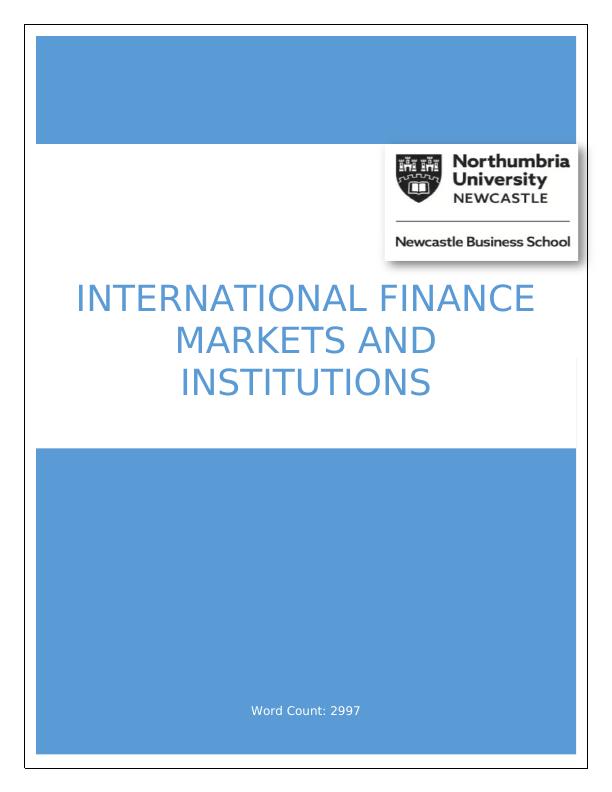
Contents
Executive Summary.........................................................................................................................2
Question 1: Money Markets............................................................................................................3
Question 02: Bond Market...............................................................................................................8
Question 3: Stock Market..............................................................................................................11
Question 4: Central Bank Interventions........................................................................................14
References......................................................................................................................................16
Table of Figures
Figure 1: Short term debt securities issued by UK monetary Financial institutions (ONS, 2020)..4
Figure 2: Financial Net worth..........................................................................................................5
Figure 4: UK ted Spread and libor OIS Spread (Brusuelas, 2021)..................................................6
Figure 5: CP Issuance (Bank of England, 2020).............................................................................6
Figure 6: Short term bond yield (Ceicdata, 2022)...........................................................................7
Figure 7: Repo rate (tradingeconomics, 2022)................................................................................7
Figure 8: Government bond yield trend | Source (Bloomberg, 2022).............................................9
Figure 9: FTSE100 share price evolution | Source (Marketwatch, 2022).......................................9
Figure 10: UK Government bond yield curve Source: (worldovernmentbonds, 2022)................11
Figure 11: FTSE100 Index price evolution | Source: (Marketwatch, 2022).................................12
Figure 12: Percentage change in share prices of firms listed on the London Stock (Griffith,
Levell and Stroud, 2020)...............................................................................................................13
Figure 13: GBP/USD evolution (Markettrends, 2022)..................................................................14
1 | P a g e
Executive Summary.........................................................................................................................2
Question 1: Money Markets............................................................................................................3
Question 02: Bond Market...............................................................................................................8
Question 3: Stock Market..............................................................................................................11
Question 4: Central Bank Interventions........................................................................................14
References......................................................................................................................................16
Table of Figures
Figure 1: Short term debt securities issued by UK monetary Financial institutions (ONS, 2020)..4
Figure 2: Financial Net worth..........................................................................................................5
Figure 4: UK ted Spread and libor OIS Spread (Brusuelas, 2021)..................................................6
Figure 5: CP Issuance (Bank of England, 2020).............................................................................6
Figure 6: Short term bond yield (Ceicdata, 2022)...........................................................................7
Figure 7: Repo rate (tradingeconomics, 2022)................................................................................7
Figure 8: Government bond yield trend | Source (Bloomberg, 2022).............................................9
Figure 9: FTSE100 share price evolution | Source (Marketwatch, 2022).......................................9
Figure 10: UK Government bond yield curve Source: (worldovernmentbonds, 2022)................11
Figure 11: FTSE100 Index price evolution | Source: (Marketwatch, 2022).................................12
Figure 12: Percentage change in share prices of firms listed on the London Stock (Griffith,
Levell and Stroud, 2020)...............................................................................................................13
Figure 13: GBP/USD evolution (Markettrends, 2022)..................................................................14
1 | P a g e
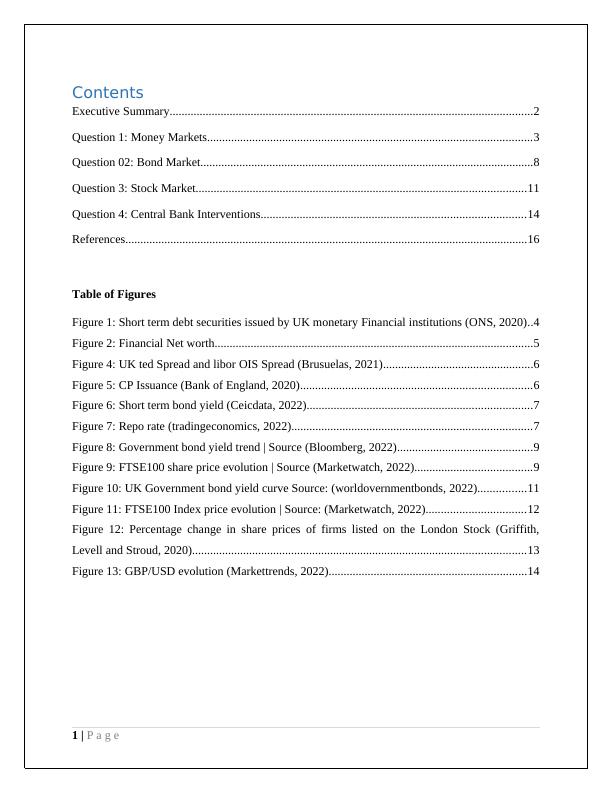
Executive Summary
The aim of this assignment is to asses and analyze the consequences of the COVID-19 on UK
financial markets. This paper is divided into four sections, they are money market, bond market,
stock market and action taken by European central bank to intervene and maintain financial
stability and growth. Findings suggests that the impact of the covid-19 pandemic was substantial
and as a result the financial markets were negatively impacted; the paper further investigates
market behavior of investors during the pandemic in various markets as well as the steps taken
by the central monetary authority in minimized the negative impact on the economy.
2 | P a g e
The aim of this assignment is to asses and analyze the consequences of the COVID-19 on UK
financial markets. This paper is divided into four sections, they are money market, bond market,
stock market and action taken by European central bank to intervene and maintain financial
stability and growth. Findings suggests that the impact of the covid-19 pandemic was substantial
and as a result the financial markets were negatively impacted; the paper further investigates
market behavior of investors during the pandemic in various markets as well as the steps taken
by the central monetary authority in minimized the negative impact on the economy.
2 | P a g e
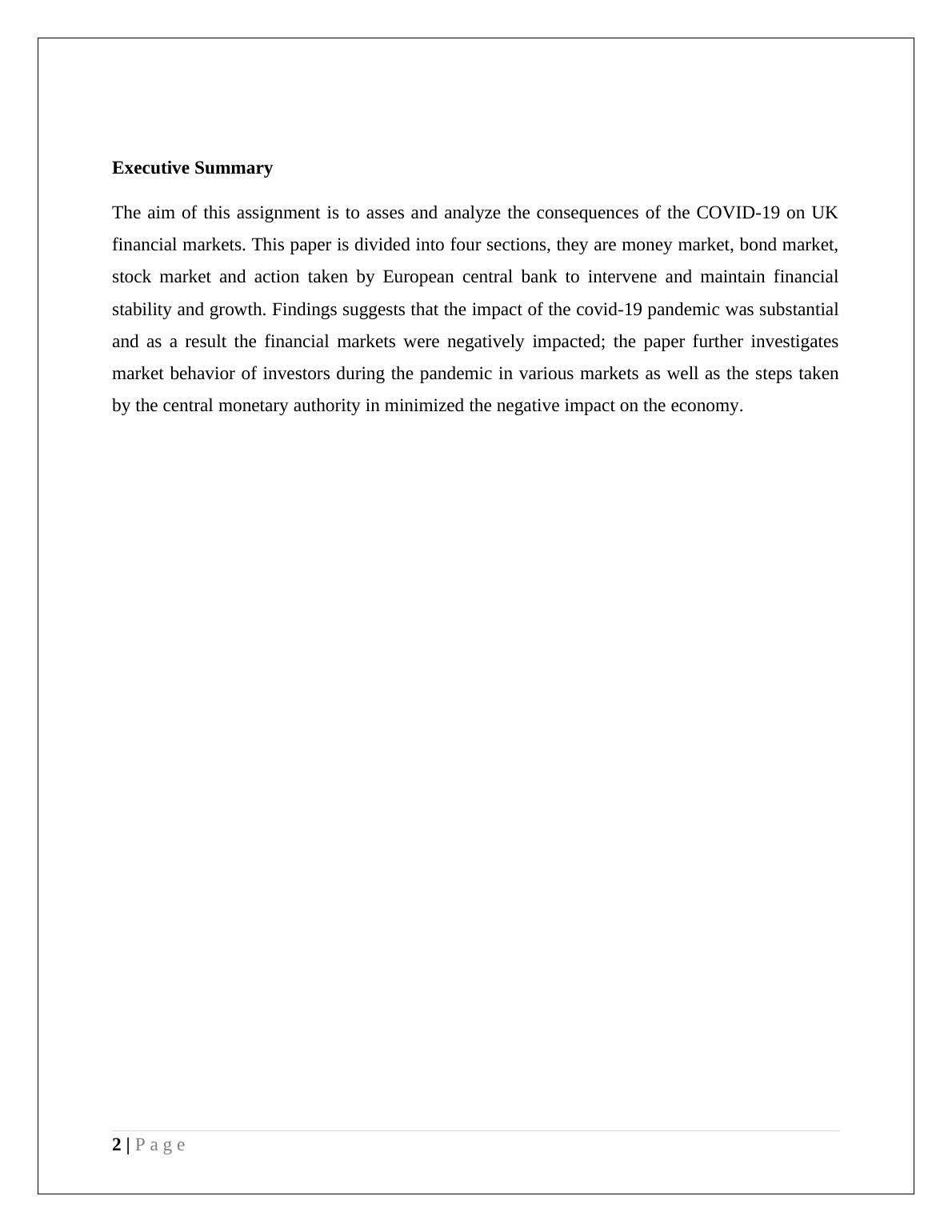
Question 1: Money Markets
The money market is a component of the economy which provides short term funds and one of
the pillars of the global financial system; this market involves the buying and selling of large
amounts of short term debt products such as commercial papers and overnight reserves. A key
characteristic of the money market is the high level of safety and relatively low rate of return
(Hayes, 2021). The money market is essential for the smooth functioning of a modern financial
economy as it allows savers to lend money to those who require short term loans and helps to
allocate capital for productive use. The COVID-19 pandemic made a big impact on the world
economy, in this section the impact of COVID-19 on the United Kingdom (UK) money market
will be analyzed.
The COVID-19 pandemic which is a health crisis that led to a global economic crisis due to its
significant negative impact on financial markets. It is estimated that the global economy was
negatively impacted by approximately 2.7 trillion USD (Bloomberg, 2020).
With regards to the UK money market, the changes in securities were driven by revaluations
which were predominantly driven by foreign exchange rates and/or the market price; however,
for deposits and loans, the impact of price changes was limited and explained by a high volume
of transactions between sectors. Both financial and non-financial corporations saw record
increases in deposits and loans in Quarter 1 (Jan to Mar) 2020 and the degree of cash holding by
corporations and households was unprecedented. A shock to the financial sector causes lenders
to build additional default risk into funds available to the business community. The interest rate
difference between commercial rates and risk-free rates is a measure of that default risk
(ONS.gov.uk, 2020).
As per figure 1 the volume of short term debt securities issued by UK monetary financial
institutions declined in 2020. This was due to banks buying back securities from money market
funds and issuing fewer securities. Further, the UK government launched a lending scheme
called The COVID Corporate Financing Facility (CCFF) to provide short-term bridging finance
for large businesses hurt by the spread of coronavirus (bankofengland, 2020).
3 | P a g e
The money market is a component of the economy which provides short term funds and one of
the pillars of the global financial system; this market involves the buying and selling of large
amounts of short term debt products such as commercial papers and overnight reserves. A key
characteristic of the money market is the high level of safety and relatively low rate of return
(Hayes, 2021). The money market is essential for the smooth functioning of a modern financial
economy as it allows savers to lend money to those who require short term loans and helps to
allocate capital for productive use. The COVID-19 pandemic made a big impact on the world
economy, in this section the impact of COVID-19 on the United Kingdom (UK) money market
will be analyzed.
The COVID-19 pandemic which is a health crisis that led to a global economic crisis due to its
significant negative impact on financial markets. It is estimated that the global economy was
negatively impacted by approximately 2.7 trillion USD (Bloomberg, 2020).
With regards to the UK money market, the changes in securities were driven by revaluations
which were predominantly driven by foreign exchange rates and/or the market price; however,
for deposits and loans, the impact of price changes was limited and explained by a high volume
of transactions between sectors. Both financial and non-financial corporations saw record
increases in deposits and loans in Quarter 1 (Jan to Mar) 2020 and the degree of cash holding by
corporations and households was unprecedented. A shock to the financial sector causes lenders
to build additional default risk into funds available to the business community. The interest rate
difference between commercial rates and risk-free rates is a measure of that default risk
(ONS.gov.uk, 2020).
As per figure 1 the volume of short term debt securities issued by UK monetary financial
institutions declined in 2020. This was due to banks buying back securities from money market
funds and issuing fewer securities. Further, the UK government launched a lending scheme
called The COVID Corporate Financing Facility (CCFF) to provide short-term bridging finance
for large businesses hurt by the spread of coronavirus (bankofengland, 2020).
3 | P a g e
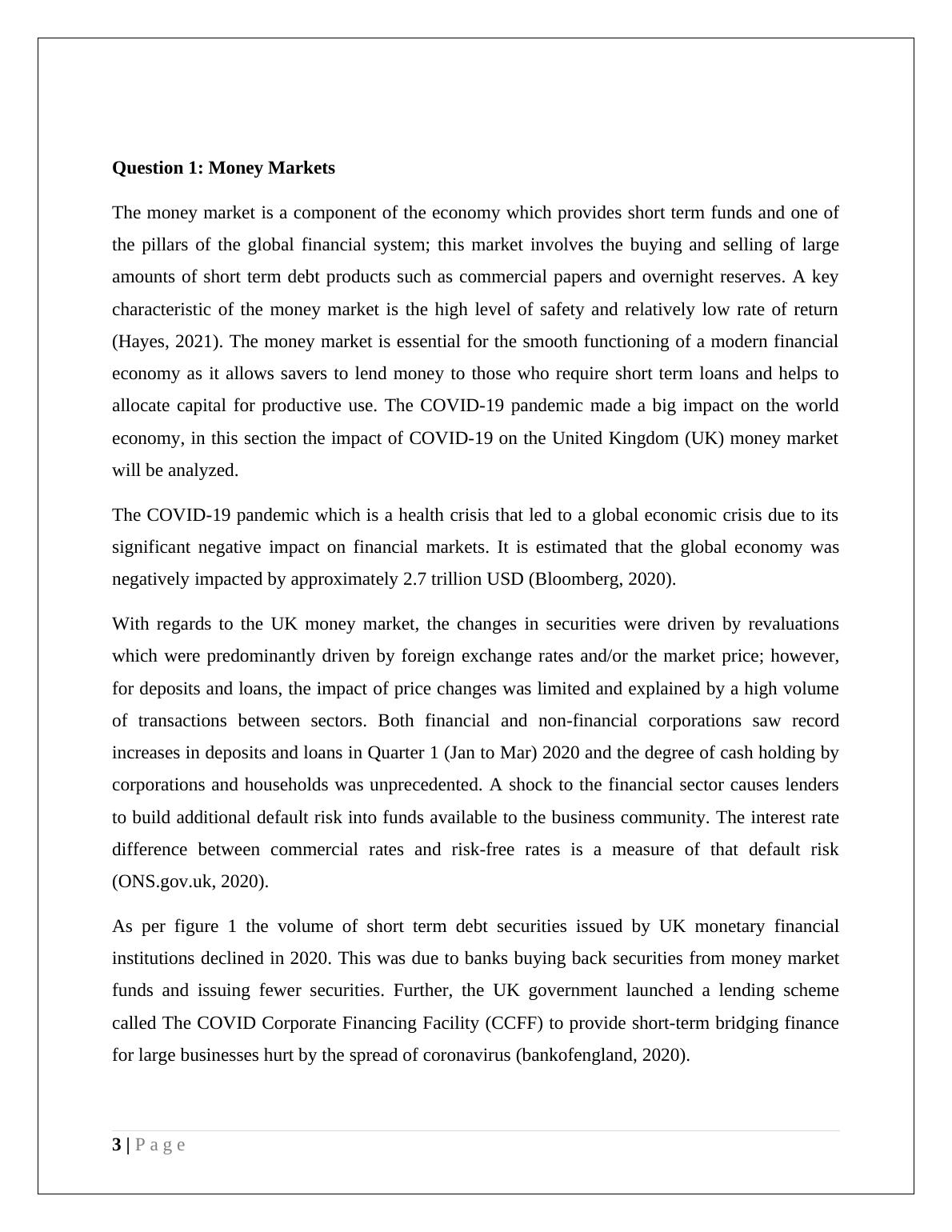
0
50000
100000
150000
200000
250000
300000
350000
Short Term Debt Securities Issued by UK Monetary Financial Institutions
Figure 1: Short term debt securities issued by UK monetary Financial institutions (ONS, 2020)
4 | P a g e
50000
100000
150000
200000
250000
300000
350000
Short Term Debt Securities Issued by UK Monetary Financial Institutions
Figure 1: Short term debt securities issued by UK monetary Financial institutions (ONS, 2020)
4 | P a g e
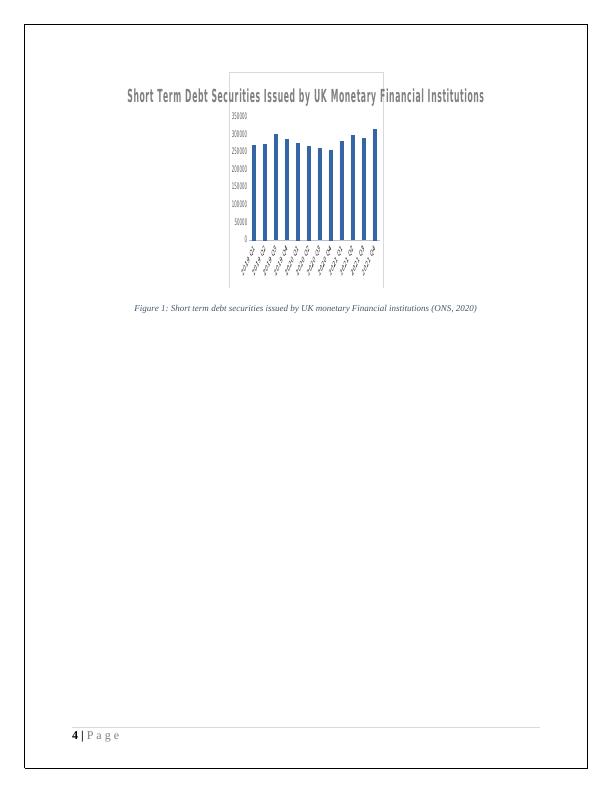
Figure 2: Financial Net worth
Figure 2 highlights how private non-financial corporations increased their liabilities of debt
securities in 2020, as the CCFF and corporate bond issuance supplied liquidity to larger firms.
According to the Bank of England, PNFCs issued £28.4 billion of bonds in Quarter 2 2020,
which was a 75.3% rise from a year earlier.
with compression of interest rates, as indicated in figure 3 and figure 4, U.K. T-bill rates were
negative, Euro-pound rates and overnight indexed swap rates are being mere 4 basis points, and
money market spreads remained negligible.
5 | P a g e
Figure 2 highlights how private non-financial corporations increased their liabilities of debt
securities in 2020, as the CCFF and corporate bond issuance supplied liquidity to larger firms.
According to the Bank of England, PNFCs issued £28.4 billion of bonds in Quarter 2 2020,
which was a 75.3% rise from a year earlier.
with compression of interest rates, as indicated in figure 3 and figure 4, U.K. T-bill rates were
negative, Euro-pound rates and overnight indexed swap rates are being mere 4 basis points, and
money market spreads remained negligible.
5 | P a g e
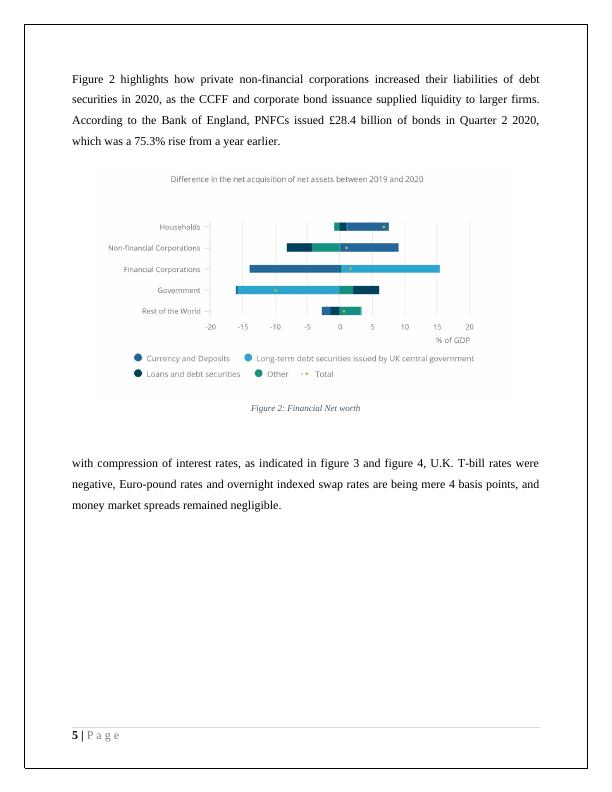
End of preview
Want to access all the pages? Upload your documents or become a member.
Related Documents
Impact of Quantitative Easing on Financial Markets and Econometricslg...
|5
|707
|240
Economic Analysis of Reserve Bank of Australia's Monetary Policy and COVID-19 Impactlg...
|7
|584
|185
Economic Impact of COVID-19 and Government Response in UKlg...
|11
|3450
|206
Impact of COVID-19 on International Firms and Risk Mitigation Plans: A Case Study of Tescolg...
|13
|3275
|87
UK Government's Strategy to Combat Inflation through Interest Rate Hikeslg...
|7
|786
|371
Macroeconomics and the Impact of COVID-19 on Local and International Trade, Purchasing Behaviour, Inflation, and Vaccinationlg...
|11
|3833
|375
